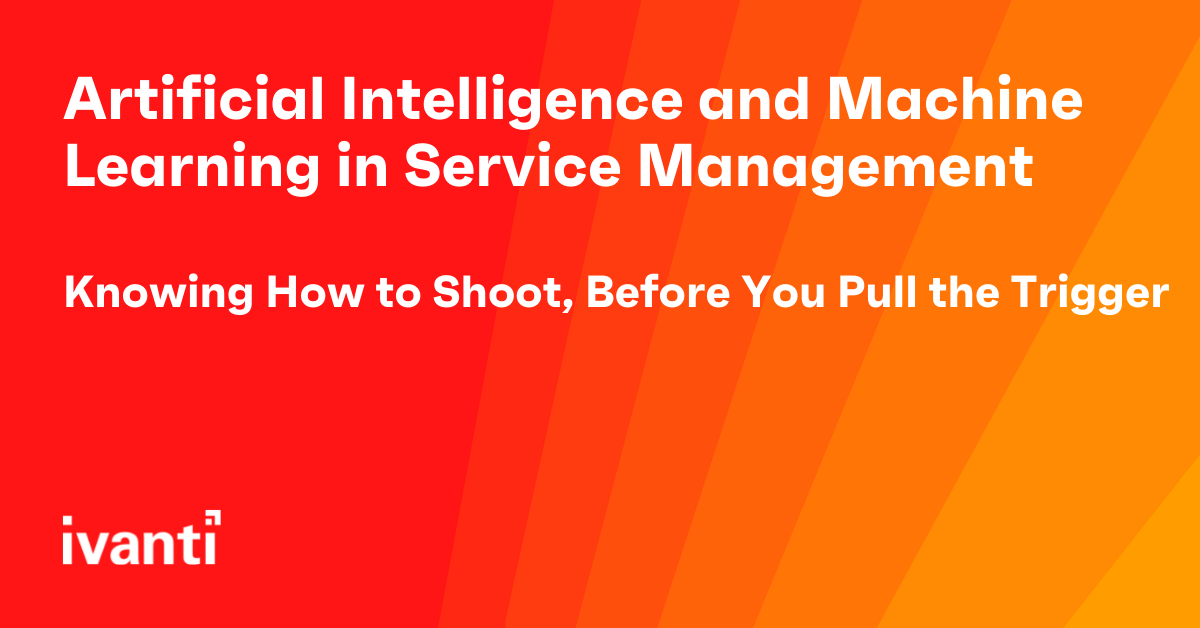Artificial Intelligence and Machine Learning in Service Management - Knowing How to Shoot, Before You Pull the Trigger
Earlier this year we enjoyed an offsite day in the country, and one of the activities was laser pigeon shooting. Now don't worry, no pigeons were harmed on the day, we were simply using clay targets, modified toy guns with lasers and a couple of dusty, old speakers to provide shooting and explosion sound effects.
We knew we had a sharpshooter in the group, but on this particular day, he could not get his aim right and hit nothing. Now how does this relate to service management and artificial intelligence strategies?
Well, it’s all about the approach and getting the foundations right. Our friend, the sharpshooter had misinterpreted some of the instructions, so everything was out of sync, therefore his aim was off and although technically the best shot, came home with a duck.
Similarly, if we start looking at artificial intelligence and machine learning strategies to improve our existing service management solution, we need to get the underlying data correct, understand where the currents problems lie, and only then, apply the new technology to bring our solution to the next level.
All roads lead to Artificial Intelligence…
The phrase “artificial intelligence” is appearing in most conversations today whenever technology is being talked about. Whether it's AI driven drones which are scouring the countryside looking for fires, or it’s being used in big data for predictive modelling by banks and healthcare research, AI is seen as a lever to get a step up on your operations, get quicker results and remove labour intensive activities. Vendors also see the value, and the perception, of integrating as much "artificial intelligence" into their product portfolios to get the edge on their competition.
So what can it deliver?
What does it mean for service delivery teams and how can they leverage advances in artificial intelligence and machine learning to help the teams (or indeed hinder them)? Expectations can be high, so the inability to bring quick wins could be seen as a failure by the teams or the technology they are using.
Where it can help, significantly, is where service delivery teams look at artificial intelligence and machine learning with a practical approach and look at the problem to be fixed, before applying a solution to it.
A common misconception is the implementation of artificial intelligence and machine learning can deliver quick wins with the ability to resolve incidents automatically or detect problems quicker. These can be quick wins; however the underlying operational data needs to be in a good state before we layer over new technologies.
Poor Data + AI = Getting to the wrong answer faster
Readying for artificial intelligence and machine learning implementation
So how do we ready our service management implementation to leverage artificial intelligence and machine learning?
Let's go back to where we talked about defining the problem first before we implement a solution.
A big focus (and indeed sticking point) historically in service management is about the accuracy of metrics and their usefulness. One common theme I have seen over the years is ticket categorisation. The approach has been tweaked over the years – more detailed categories, then less details, making them mandatory, then realising people pick any value if it’s mandatory. Ultimately it comes down to the decision of an individual or a set of rules that were correct at a point in time. When a ticket is categorised correctly, the subsequent processes are then on the right tracks to run smoothly:
- assigned to the right group,
- applies the correct SLA,
- present the right knowledge and
- triggers the relevant automations,
This all helps to ensure the ticket is resolved in the shortest possible timeframe.

So how can you get it right?
As in our user story above, by taking away the decision-making process and leaving the machine learning models to parse through the description text and apply a machine learnt categorisation to a ticket, it provides a huge opportunity for service desks to modernise their approach, speed up ticket processing and leverage other areas of the solution correctly – because the first categorisation of the ticket is correct.
Now hold up a minute I hear you ask….what if the machine is wrong, or not quite right? We’ll have tasks, emails and integrations triggering automatically with no checks in place. Good question!
The Machine Learning models not only have a prediction algorithm, but will also work out their confidence levels, so we can only apply the subsequent automations if the model is say, 90% confident. So, there will always be the need to train and tune the models.
Loop back to our original problem statement and we now see accurate and actionable reports, that have meaning and relevance and can be used in decisions.
Is AI worth it?
Simply attempting to layer artificial intelligence and machine learning into your service management processes may not achieve much when compared to other technologies which are turbo boosted by the sight of it.
We should think carefully about what problems we first need to solve and ensure there is a good baseline of data quality. Then you can gradually introduce initiatives, such as machine learning categorisation to drive good data quality practices. Once these foundations are in place, the real fun can begin where we start to leverage artificial intelligence and machine learning to auto remediate incidents, auto detect and resolve problems or use predictive analytics when changes are expected.
Remember, we brought the best shot we had to laser pigeon shooting and because he didn’t have the basics right, he hit nothing. If you would like to see how you can leverage AI and ML and start with the right foundations to self-heal incidents and proactively detect problems then please get in touch to book a demo of Ivanti Neurons.
